Located in the heart of Mumbai, the Museum of Solutions (MuSo) is a unique institution dedicated to nurturing the problem solvers of tomorrow. It offers a blend of theme-based exhibits, immersive experiences, learning and development programs, creative labs, and a library filled with curated children’s books. The museum aims to inspire children to think creatively and positively impact their communities.
Since its inception in 2023, MuSo has been a hub for innovation and forward-thinking. It is designed as a space where visitors can learn, discover, and create. The museum features a diverse range of exhibits showcasing innovative solutions in sustainability, technology, and the arts, providing real-world examples of positive change. Additionally, MuSo organises workshops and events for all ages, fostering a community of lifelong learners and change-makers.
Led by the expertise of the architectural team at RJB CPL’s Ratan J Batliboi and Bombay Bricolage’s Vinit Nikumbh, and Sterling Engineering Consultancy Services Pvt Ltd, represented by Nilesh Karmalkar and Shekhar Tambe, MuSo has become a vibrant hub where inspiration meets education.
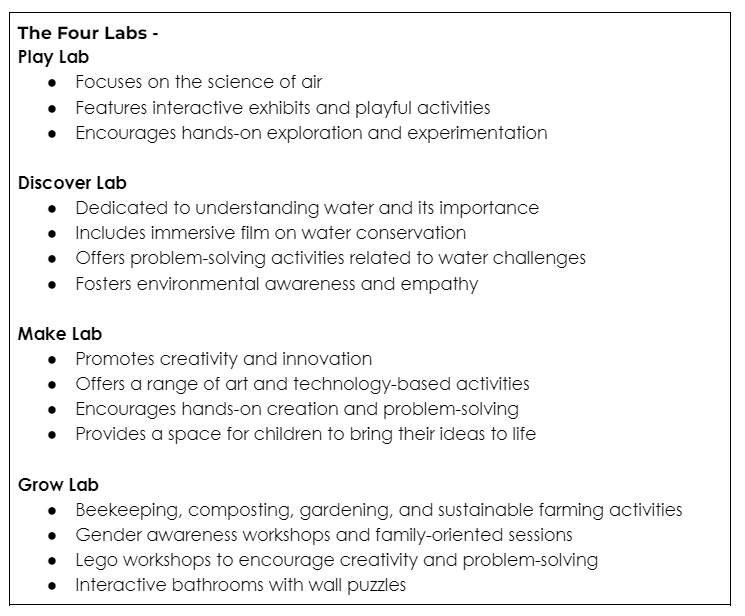 A Child-Centric Space
A Child-Centric Space
A concerted effort between the JSW Foundation and architectural firms RJB-CPL and Bricolage Bombay, MuSo was brought to life through a child-centric design process. The project began in 2017 with extensive stakeholder discussions to define the museum’s programs and exhibits. While an existing mill building was initially considered for the site, practical constraints led to the design and construction of a new building, which commenced in December 2019 and was completed in 2022 amidst the challenges of the COVID-19 pandemic.
Initially conceived as a showcase for structural steel applications, the project evolved into a comprehensive space dedicated to inspiring young minds to become agents of change.
A Collaborative Vision
At an architectural level, several considerations made the project unique. Factors such as the need for ample daylight, the three-tiered front façade and the triple height void for the Luckey Climber, a 30 ft tall vertical maze for children, each presented its own set of challenges. But the large team of specialists and super specialists worked together at every stage to guarantee that the overall objective of the project was not compromised.
The old mill had a water tank as a plinth and while constructing the new structure, the existing foundations acted as shoring, ensuring that basement shore piling was not required. However, the foundations were a challenge due to the proximity of the neighbouring buildings. At a structural level, very quickly the decision was made to use steel to enable faster construction with the use of composite columns.
 A notable feature of the project is the choice to have an exposed slab without a false ceiling. While unconventional, this decision was driven by the program’s requirements, which included many exhibits and displays on the three main gallery floors: The Play, Make, and Discover Labs. The exposed slab provided the necessary flexibility for temporary setups that a false ceiling could not offer.
A notable feature of the project is the choice to have an exposed slab without a false ceiling. While unconventional, this decision was driven by the program’s requirements, which included many exhibits and displays on the three main gallery floors: The Play, Make, and Discover Labs. The exposed slab provided the necessary flexibility for temporary setups that a false ceiling could not offer.
In fact, the industrial look that was achieved aligned perfectly with the idea that in a museum such as this, exposing how the building ‘works’ in terms of services is an important cog in elevating a child’s curiosity levels.
The building’s steel bracings serve a dual purpose: enhancing structural stability and contributing to the aesthetic appeal of the front elevation. The use of slender, 700 mm deep built-up section spans effectively supports the expansive museum floors. These steel beams were deliberately left exposed by the architects to enhance aesthetics, eliminating the need for false ceilings.
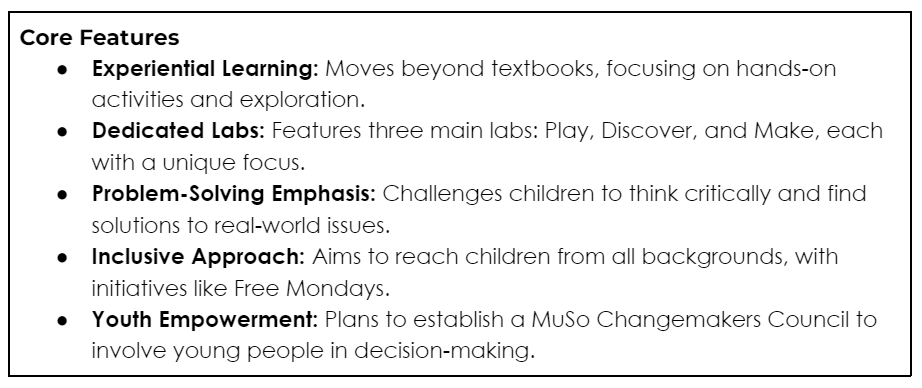 Time and Teamwork
Time and Teamwork
The MuSo project experienced a prolonged development phase for various reasons. The building proposal went through multiple iterations before final approval. Concurrently, extensive participatory sessions were held with children, educators, and parents to develop a program that accurately reflected the users’ needs. Additionally, many key project collaborators were not based in the city, and some were even abroad, necessitating detailed planning and coordination.
The construction phase, which took place during the COVID-19 pandemic in 2020-21, brought its own set of challenges. However, since JSW Realty, part of the same group, handled construction and management, it was easier to monitor the budget and timelines.
Choosing structural steel over traditional RCC helped the project address logistical challenges associated with the frequent movement of RMC mixers in a densely populated area. This decision allowed for a significantly shorter construction timeframe, contributing to overall efficiency and timely completion of the project.
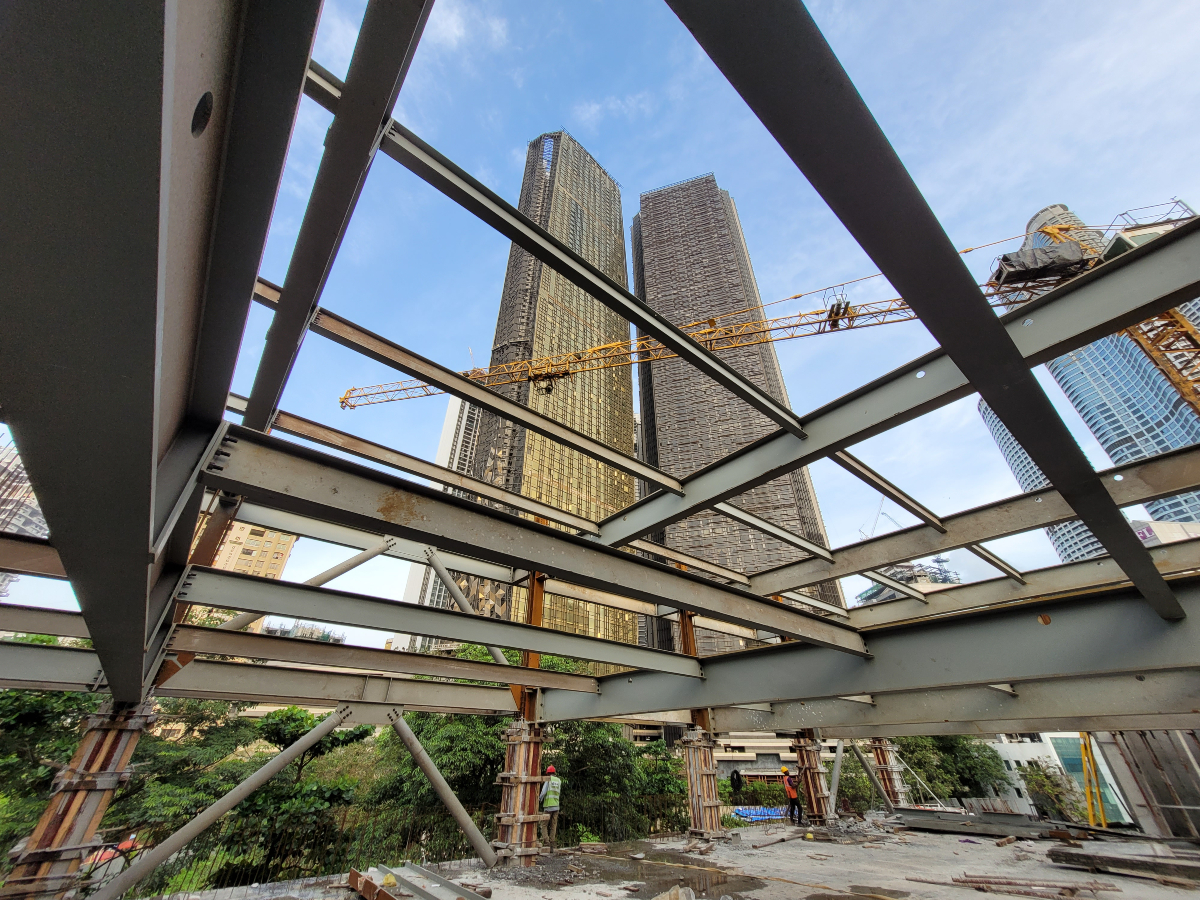
Against the odds
The MuSo project chose steel primarily to speed up construction and give the building a lighter appearance, avoiding the need for bulky RCC columns on the exterior. This decision was crucial to maintaining a column-free interior, despite the large 10,000 sq ft floor plate. Exposing the steel in select areas contributed to an industrial aesthetic, fitting well with the museum’s hands-on, problem-solving ethos.
The project faced challenges with its foundation system due to the remnants of thick load-bearing walls from an old mill on the site. These underground walls complicated the piling process, requiring some columns to be strategically floated from cantilevered pile caps to work around the existing structures.
With limited space around the site, the foundation design needed to avoid impacting neighbouring buildings. Hence above ground, the peripheral columns were positioned in a way such that they were slightly inset and the slab was cantilevered outside. Secondly, the building edges had to be detailed in a manner that ensured water tightness. The maximum permitted building height was 45 m, dictated by fire safety regulations. To optimise the use of space, the parking floors were set at 3.3 m, while the other floors were standardised at 4.2 m, maximising the building’s height and floor plate extent without compromise.
The absence of shear walls on the front elevation was compensated for by employing the use of Y bracings that provided the requisite lateral stiffness.
As India’s first installation of its kind, the Luckey Climber was positioned to be a central attraction in the museum. The requirement was a triple-height void at a location within the floor plan that was in close proximity to the lift lobby and also placed in a way that it would be visible from various places. This placement was crucial to maintain accessibility during periods of high visitor traffic, making it a prominent and engaging feature for all visitors.
The project also faced torsional irregularity issues due to eccentric shear wall cores. To address this, steel bracings were introduced, not only controlling torsion but also enhancing the building’s front elevation with additional openings that added aesthetic value. Slender 700 mm deep built-up sections were used to support the long spans of the museum floors, and the exposed beams contributed to the building’s modern look by eliminating the need for false ceilings. Additionally, composite columns with UC sections embedded in reinforced concrete (RCC) were employed, reducing column sizes and maximising the usable floor area.
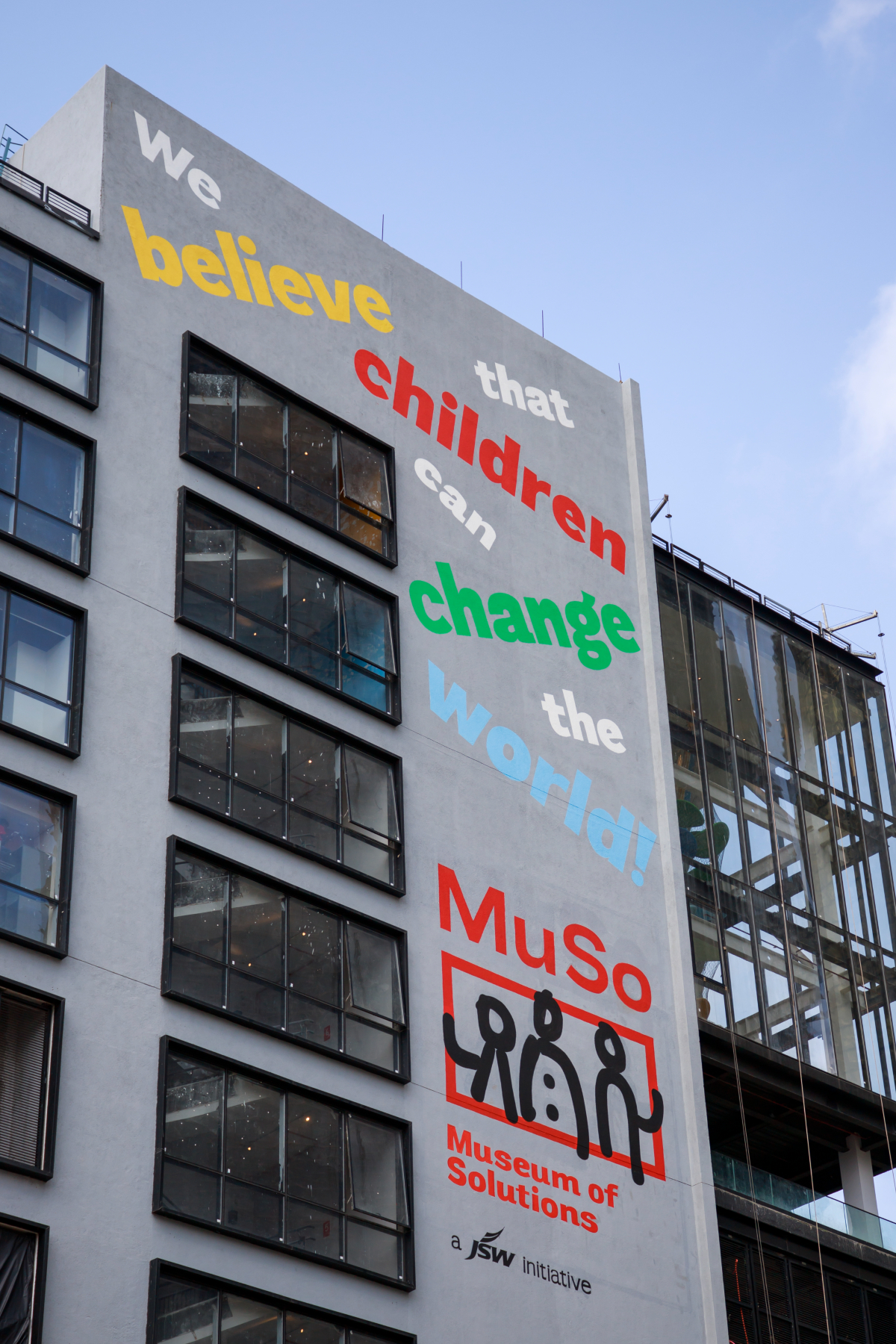
A Digital Blueprint
For a project of this type and scale, using STAAD modelling for the analysis and design of structural components has become almost standard. This particular software’s compatibility with other programs and its ability to handle the building’s composite structural system made the team’s work much more manageable. The use of energy modelling and automated processes in component fabrication, such as computerised welding, ensured a high level of precision, safety, and compliance with standards.
The sustainability team created a simulated model of the proposed building, reviewing sunlight incidence, the impact of neighbouring buildings, and other environmental factors. This analysis allowed the team to predict potential energy savings compared to a baseline building. This integrated design approach provided multiple layers of information and benchmarks, aiding in material selection, volumetric responses, and understanding building conditions by simulating energy use throughout the building’s operational year.
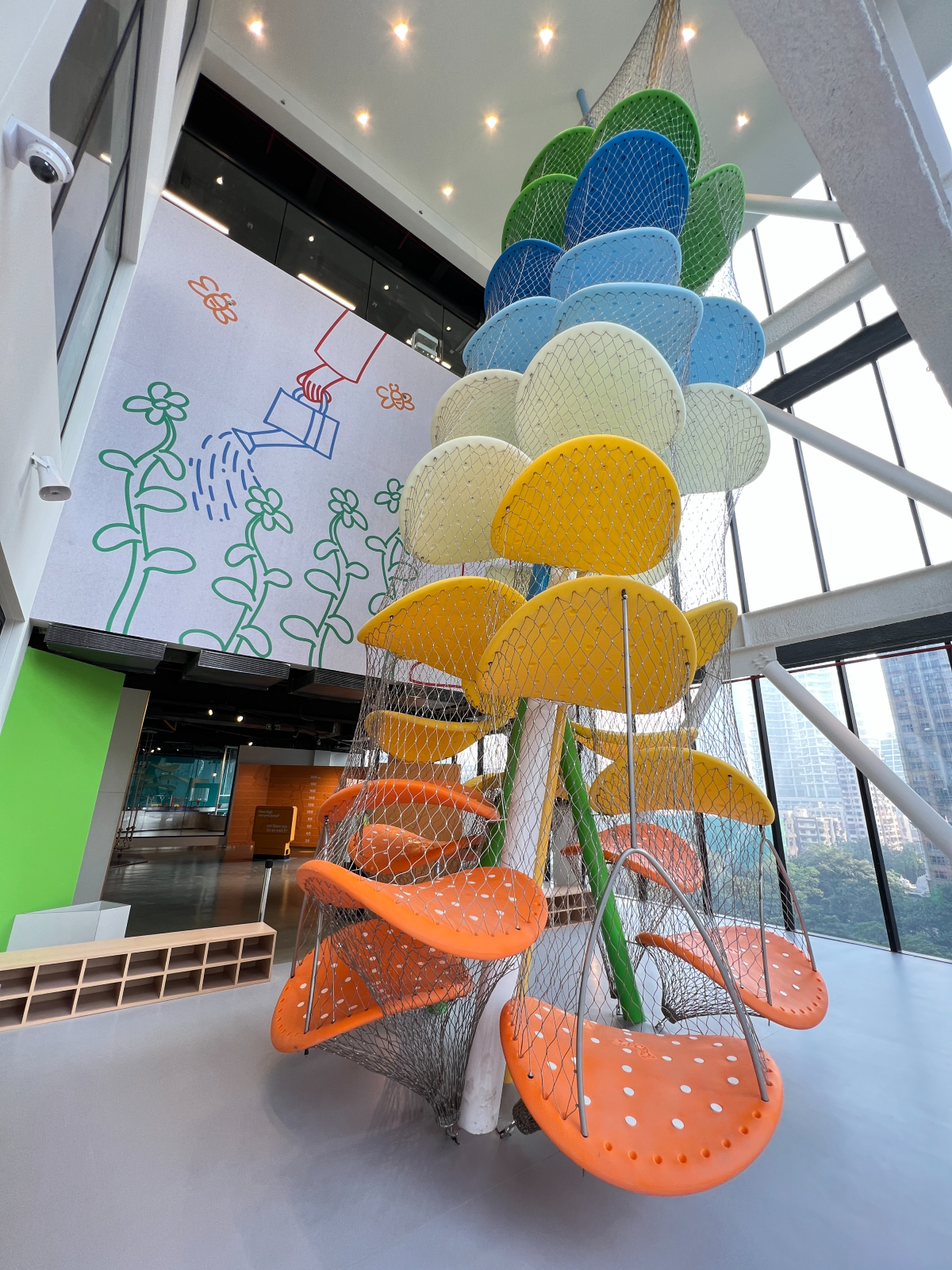
Urban Sustainability
From the outset, sustainability was a core element of MuSo’s design philosophy. The project team believed that a building designed to instil values of sustainability in future generations should embody those principles itself. However, MuSo’s sustainability approach is not overtly traditional; it demonstrates that materials like mud and bamboo aren’t the only sustainable options. The design emphasises the importance of certifications to ensure comprehensive sustainability practices.
Given its location in the heart of Mumbai, MuSo is a multi-story institutional building where sustainability is achieved through smart technology, economical energy-saving devices, and emission reduction strategies. The design adheres to the LEED criteria, focusing on energy usage, water conservation, waste management, construction best practices, site conditions for personnel, landscape design for air quality, public education, and more—covering over 100 aspects that contribute to a holistic sustainable approach.
MuSo’s alignment with these sustainability measures has enabled it to apply for a Gold LEED rating, with the building meeting 82 out of 100 possible points, showcasing a strong commitment to environmental responsibility and sustainability in urban architecture.
MuSo is a testament to the power of design and engineering to create extraordinary spaces. A harmonious blend of innovation and practicality, it stands as a landmark achievement in contemporary architecture.
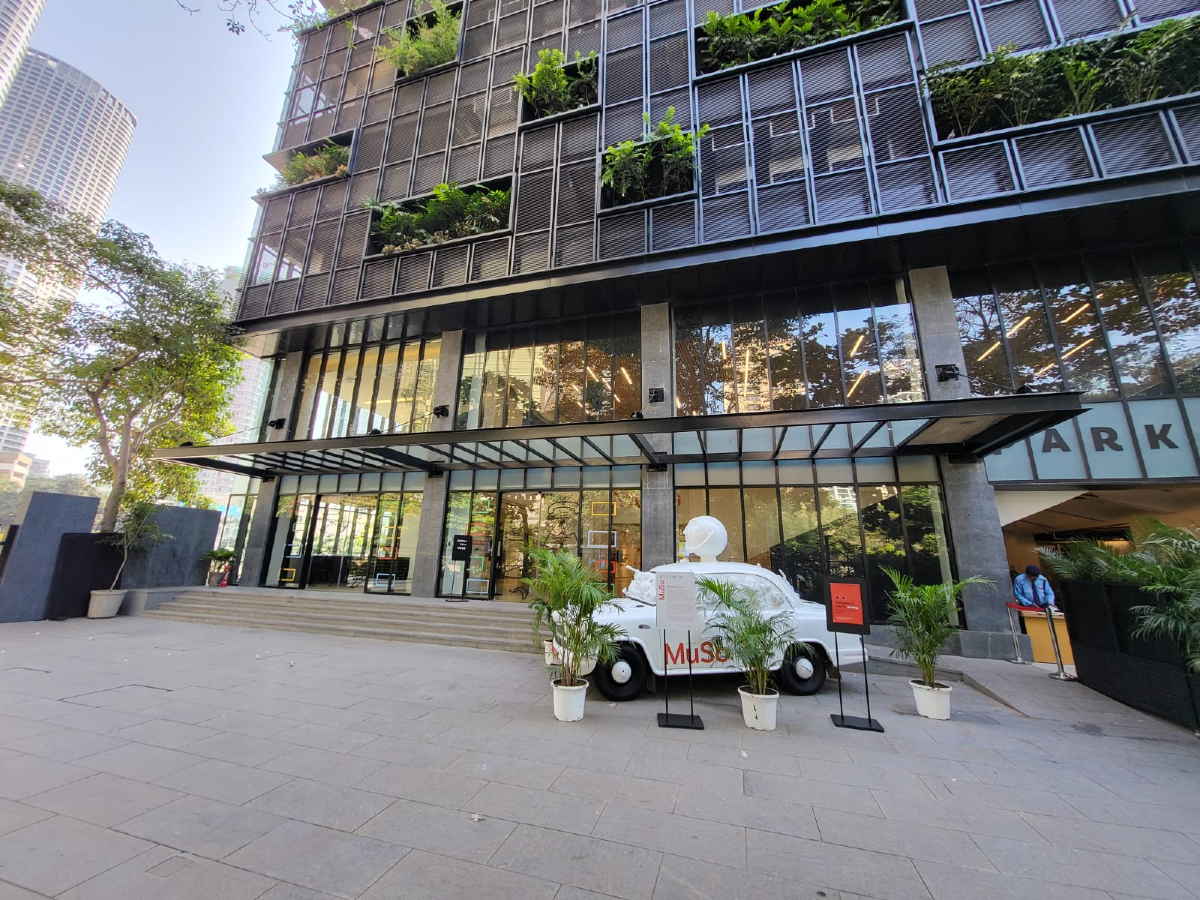 Quote
Quote
“The design process of MuSo reflects the collective efforts of all the multidisciplinary teams involved, which included several specialists and super specialists, none more critical than the children themselves who took on the role of co-creators. The sensitivity to the environment, integration of technology and seamlessness of the interiors are a few key design aspects that coalesced to create a unique museum experience for the city of Mumbai.”
Ratan J Batliboi & Vinit Nikumbh, Project Architects, Ratan J Batliboi Consultants Pvt Ltd & Bricolage Bombay
“The decision to utilise structural steel over RCC helped us overcome logistical challenges, such as the continuous movement of RMC mixers in a densely populated area, significantly cutting down construction time. Additionally, by prioritising sustainability in the building’s design, we incorporated recyclable structural steel, which not only facilitated LEED certification but also reduced concrete consumption by 50%, thereby minimising our carbon footprint.”
Nilesh Karmalkar & Shekhar Tambe, Sterling Engineering Consultancy Services Pvt Ltd
Fact File
Client: JSW IP Holdings Pvt Ltd
Architect: Ratan J Batliboi – Consultants Pvt Ltd, Bricolage Bombay
Consultant: Sterling Engineering Consultancy Services Pvt Ltd
Fabricator: JSW Severfield Structures Ltd
Tonnage: 500 MT
Status: Completed





